EHang 184 is a Manned UAV You Will Never Get to Fly

EHang, the maker of the Ghost Drone just launched something at CES 2016 which might get a lot of folks excited. It’s basically a manned version of a traditional drone UAV called EHang 184 that provides means of personal transportation for a single passenger weighing not more than 100 kilograms or 220 pounds.
So first of all it’s not going to be the choice of NFL linemen because this maximum payload is for the passenger and personal belongings (luggage) combined. So a reasonable sized person would not be able to fly it having boots on :). The 184 was named for ‘one’ passenger, ‘eight’ propellers, and ‘four’ arms.
It’s a bit less ingenious than expected, I would personally like a less dull name for something that tends to be cool, for example the EHang Storm (copyright).
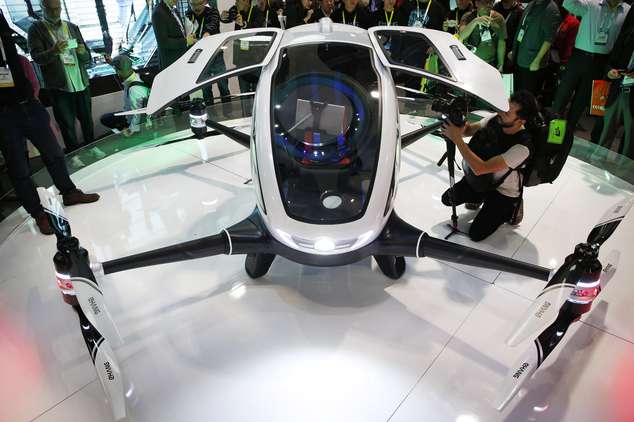
The EHang 184 at CES. Photo Credit: AP Photo, John Locher
Other attempts to create a manned version of “drones” range from the Hoverbike which is at least a cool concept to the Flike which is a bit hard to take seriously, looks extremely dangerous to fly. None of these guys made it to the market just yet.
Looking for a guide to picking the best drones with cameras?
But let’s look at the announced characteristics of EHang 184 to assess what’s great and not so great about it. If anything, these types of drones are at least guaranteed to give you the fpv drone flight you’re looking for if you’re into that sort of thing, this is real live FPV!
Ehang 184 Rotors and Configuration
The EHang 184 is very similar to a multicopter UAV with an X8 configuration. If you are not sure what the different configurations mean, check out our post. Obviously, a manned multicopter that would be trusted to carry a passenger can not be a quadcopter because if only one motor would malfunction, the vehicle would fall to the ground like a brick. Guaranteed.
Actually, the X8 configuration is very dear to me as that is what we use in film making (feel free to check out Aircamfilm on FB). Imagine two quadcopters placed on top of each other. The X8 configuration features 8 rotors placed on four arms so it combines the maneuverability and agility of a quadcopter with the redundancy of an octocopter.
Safety
So the X8 configuration is a good choice but only if configured right because I could not find any information as to how the ESC-s are placed and how many separate controllers are used, what type they are, etc. EHang does say that there are “multiple backups” in place, but what they mean is unclear. The key here is to have separate boards of redundancy where both controllers and ESCs are backed up by fallback systems.
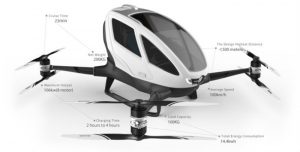
• “Multiple backups” in place
• 4 of the 8 rotors can stop and the vehicle could be able to land safely
• The 184 AAV is embedded with Ehangen fail safe system
• Auto-landing in case of trouble
• On-Star-like command center for fliers who need help
In that case, theoretically even 4 of the 8 rotors can stop and the vehicle could be able to land safely. EHang’s CEO mentioned in an interview that even if 6 motors would fail on 3 of the arms, the AAV (Autonomous Aerial Vehicles) would be able to “spiral to the ground” safely. Well, that sounds kind of scary, doubt that it would not result in anything anyone can survive. The manufacturer says that “the 184 AAV is embedded with Ehangen fail safe system” which suggests that they designed their own solution. Hope they release more information on that.
At the same time, unlike winged aircraft multirotors do not have a gliding capability and that could be a concern. I guess EHang could mount an automatically deploying parachute like a BRS chute to let the vehicle ascend safely. But if there is no such system involved and the passenger has to bail due to a malfunction, the 8 rotors being right next to the doors is a bit of a concern. I am no aircraft designer, but it would seem reasonable to place the rotor blades above the craft for added security. Placing the rotors up high would also prevent bystanders from getting injured while takeoff and landing.
Prop guards have been used on multirotors for quite some time. For example the Hoverbike is designed to have them. Why the EHang 184’s are not equipped with ducted motors is also an interesting question. It could be my ignorance and I am sure the guys over at EHang have considered that but would love to find out what the reason is.
EHang 184’s Power Supply
The 184 will have a 23 minute flight time roughly allowing a 10 mile flight as announced at CES this week. Whether that, combined with a 2-4 hour charging time is sufficient for day-to-day use depends on the owner’s personal situation, but to me it seems a little too limited. Information is scarce at this time as to the type of battery the 184 will use, but the flight time suggests Lithium Polymer and that could also be a concern to be honest.
LiPo batteries are great, most UAVs use them, but they have to be handled correctly and tend to lose voltage suddenly in certain conditions such as cold weather. How you store and deplete them is also an issue, check out our guide on LiPo battery care.
Being zero emission is all great, but EHang should consider other power supply options like hybrid power (just an idea) in order to make the EHang 184 a reasonable alternative to small helicopters.
EHang 184 Control Mechanism
Now this is where it gets really scary. Reports from the EHang booth at CES say that the “pilot” or better say passenger in the cockpit will not have a chance to fly the aircraft or take over controls from the autonomous system. Well, not being able to fly the aircraft is a problem because it takes away most of the fun I would imagine owners could have owning this puppy.
A system similar to waypoint flying in UAVs that simply takes you to a desired location by just clicking on it on Google Maps sounds great as an option. But only as an option. Not the only way to fly the aircraft. I know not all possible future users are multirotor fanatics but I am quite sure that the first people to get one of these would be them. And not letting them fly the damn thing seems like a really bad idea.
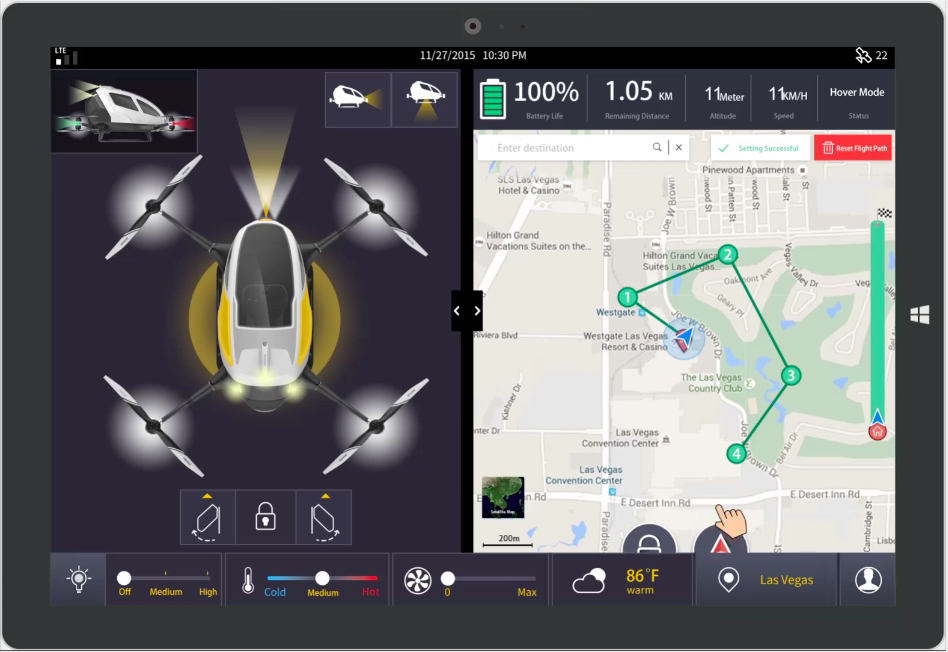
According to the announcement, in case of emergency situations the EHang 184 will be piloted by personnel sitting in command centers somewhere and help you land safely at the “nearest possible location”. Now forget the fact that they will have to build these centers first which is mostly a matter of funds and the availability of qualified pilots that can take on the responsibility of saving someone’s life from the distance.
The US already has problems with drone pilot shortages but I guess whereas those guys take lives, these pilots would be saving lives from the distance. A better headline for recruitment for sure. But what happens if there is no connectivity between the aircraft and the command station? I personally would be a bit scared to let an autonomous system combined with some command center in the distance take responsibility for my safety.
Sure, Google has self driving cars but doing that in 3 dimension in the air is a totally different ballgame. While Intel and other corporate giants are working on obstacle avoiding UAVs, this technology is simply not in the state where they could be trusted to fly manned aircraft in urban locations.
EHang 184 Pricing
Accorcing to reports, the 184 will cost between $200.000 – $300.000. Now a small but proven helicopter such as the Robinson R44 Raven I costs $355.000 brand new. It has a 350 mile range and can transport 3 passengers at 4000 feet. Ok, it is more expensive to operate probably, but the 184 must be a hell of a lot cheaper to manufacture too. So the pricing seems to be a little extreme.
The Legal Circumstances
There are countries that are more restrictive and others are less prohibitive in the use of UAVs. EHang claims that they have done more than 100 hours of test flights near their headquarters in Guangzhou, some even with a human passenger inside. At the same time, the countries with more developed regulation that is based on experience mostly require Visual Line of Sight (VLOS) for unmanned flights. But hold on for a moment.
Is the EHang 184 a manned or an unmanned aircraft? There is passenger inside. But that passenger can not control the aircraft so that does not add any level of safety during flight. Amazon also faced challenges from regulators when trying to launch delivery drones which are autonomous and unmanned. So is the EHang 184 an autonomous vehicle that transports things and that “thing” happens to be a passenger? Or is it a manned aircraft because in that case you will need a pilot’s license to fly it. But why, if you are not able to take control and fly it? Can’t wait to see first reactions from regulators around the world
Questions remain on this front but I am sure that if EHang is serious about hoping for a wide scale adoption and “revolutionizing personal transportation”, they will face a lot of scrutiny. They plan to get them certified by the authorities in China first, than the US, New Zealand and Europe. I personally don’t know of any country in the world where the EHang 184 would be legal to fly today but that is not the problem in case of revolutionary technology.

The EHang 184 at CES 2016. Photo Credit: AP Photo, John Locher.
Time to Market
According to reports, EHang plans to make AAVs or Autonomous Aerial Vehicles available later on this year. Well, this seems a bit too optimistic to my opinion as the prototype at CES was not demonstrated with any flight, even an unmanned one. Given the regulatory, pricing and other concerns, chances are that you will not be flying this thing very soon.
Our General Opinion on the EHang 184
EHang’s existing product on the market, the Ghost Drone is not a very memorable aircraft. The corresponding Facebook page has 46.000 fans and many users and testers reported that they are bit disillusioned with the Ghost. At the same time, the company raised $52 Million in a little over a year from prestigious investors. So they do have the financing and the aspiration to bring innovative products to the market but of course the industry would have more confidence in a company that has a proven track record of rock solid UAV products before launching something like this.
While lots of details remain unclear about the aircraft, we do know that it will have onboard WiFi and the reading light color will be “custom-made” according to the corporate website. Humor aside, if you watch the demonstration video, you will admire the honesty of showing how prototypes crashed and the determination the team has to make AAVs a reality.
The general concept is great and I personally would love to fly one of these things if they would only allow human control. I am sure that lots of things will change in the design concept, propulsion, power supply and other aspects of the aircraft. But in general, the determination of the design team and making this the legacy of some of their deceased team members (watch the video below) show a noble cause and let’s see if they will be able to revolutionize personal transport and succeed in making the first manned version of UAVs.
If you are interested in the marketing blurb released about the EHang 184, you can read the official press release here.
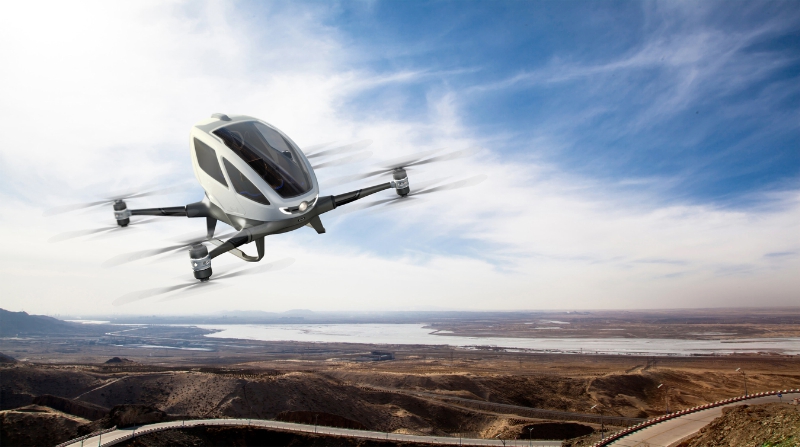




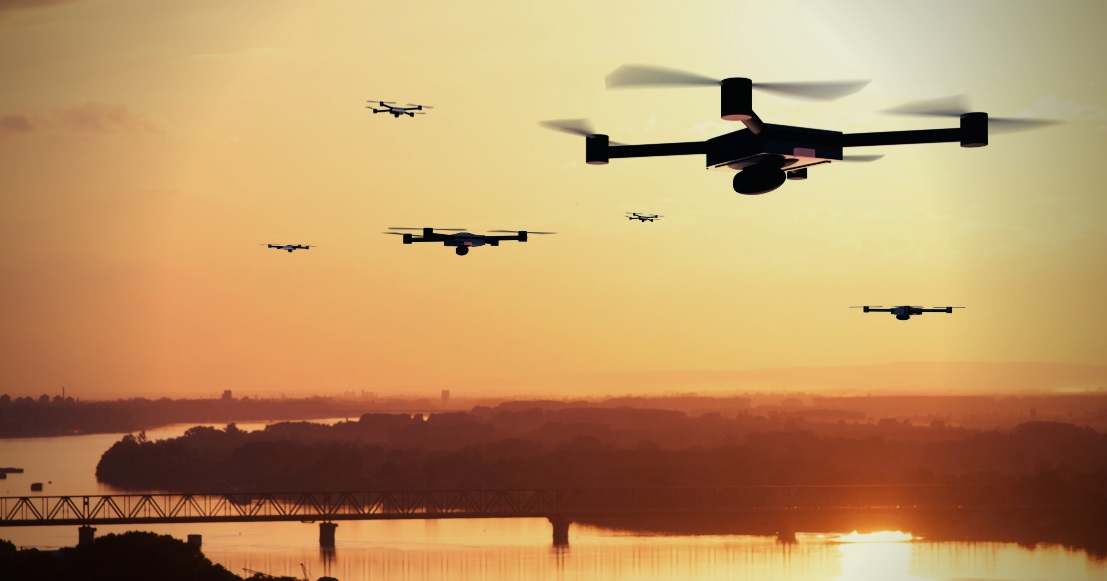

I kind of think it is a bad flight option because of its price and restraints such as flight time. If you need a pilots license to fly it how are you going to get the 40+ hours needed with 20 minute flights.
If you get a pilots license in a bigger helicopter this will grandfather in. Just like a cdl.. U get a class a cdl. You are automatically allowed to drive b N c
In RE the CDL, Classes B, D and R, are included under Class A, yes; Class C, however, is not. C is the “Bus Driver’s” license; however, by itself, it’s only good for vehicles under 26,000 lbs GVWR: if you intend to drive a bus having a GVWR greater than 26,000 lbs, you must hold both Classes B and C.
Pilot’s licenses are both class and type rated: just because you can fly a C130 doesn’t mean you can fly a 747 with the same sort of nonchalance as someone who rented a Festiva from the local Hertz store, even though each of those planes is multi-engined.
I believe there will be a whole new licensing system for these manned multi rotor Aircraft. For one you will not have a lot of people applying for a pilots license.. I also believe if you’re looking at $200-$300,000 to buy the thing, I at least want to fly it.. I have a feeling these aircraft are coming, in mass, as they should..
you would need approx 120 flights..
I love my Inspire 1! It’s very easy to fly. Also, I like the dual controller, because I get to include my wife in the fun.
Re: prop guards, they usually shorten your flight time / power, etc., it’s all trade-offs, and they already have the canopy weight to cater for. I wouldn’t include prop guards myself as I wouldn’t add ESC or motor redundancy as a safety feature (The octa configuration still has other benefits)… if those things fail you likely have a bigger problem in the craft’s electrical system, possibly fire, smoke, etc. All that race between companies and academics to be able to still manoeuver the aircraft after a X motor failure events is mostly marketing.
You need a completely separate system, like a parachute, which I’m almost certain they’ll include as even RC controlled systems use them these days.
Yes, the hoverbike included the prop guards but it’s also vaporware, IIRC there are no videos of it in flight so it might as well not exist. The Flike and the other attempts on the other hand seem to actually fly.
There are huge regulatory issues beyond what’s being discussed here.
FAA regulations require that all manned aircraft land with at least 30 minutes reserve fuel capacity. The EHang doesn’t even take off with that much “fuel” on board. How they’re going to get around that is a mystery.
A BRC has a minimum deployment altitude of about 250′ AGL. Below that that, in an emergency you might as well be in a washing machine that’s plummeting straight to Mother Earth. The FAA is going to require having a flight regime that allows the aircraft to recover from all altitudes inside the flight envelope. In helicopters this is called the “dead man’s curve” and most pilots avoid operating in it although it’s legal to do so. Unsuspecting, unrated passengers is another matter — no way the FAA is going to allow an autonomous air taxi to operate inside the dead man’s curve at all times.
The BRC also has annual inspection requirements, a limited lifetime requiring components to be replaced every few years, and other costs that amortize out to about $150/month … forever. Plus it eats about 40lbs of useful load, so you can’t fly it if you weigh more than about 170lbs naked.
Jon, their math doesn’t even make sense, 23 min is vaporware – a dream that will never come true. Maybe 5 minutes flight, if it ever takes off. Investors will get burned by this but i will be watching their saga from over promising to their inevitable failure. The funniest part was the air conditioning and lights description. These guys have no clue how things work, period.
They are absolutely going to fail getting this to be a revolutionary personal transport system for the future because of a really boring thing called physics. I am a helicopter pilot and can tell you a thing or two about it.
Firstly, the FAA requirement regarding reserves is 20 minutes for a helicopter. An AAV carrying a person will meet the same strict compliances required by any other machine able to fly and carry people (does not matter what you call it or what it is, as long as its a powered machine able to carry humans for private ops), so the Ehang AAV is not even close yet on that area alone. The price tag for certification will probably strangle this project, because the changes needed to be made will be too much. And if they are thinking of commercializing this machine for air taxi ops, its gonna be even worse.
A conventional helicopter has a main rotor and a tail rotor to counteract torque. Other types are tandem or contra-rotating. Whatever you do when you spin blades at 350 rpm plus and have power on (collective up for pitch), you will get torque issues that needs to be counteracted. If you loose the tail rotor in an R44, you simply enter autorotation and glide to the ground (an excersise you repeat hundreds of times while training for helicopter licenses)
But if you get stuck tail rotor pitch (stuck neutral or right pedals on a CCW machine, or stuck variable RPM on contra-rotating/tandem) you have a new problem. Now you need a power run on landing to maintain control all the way down. The more rotors you have, the more you complicate everything, especially when they are small and share larger loads pr unit.
To claim that this “will safely spiral down to the ground” if it looses one or more engines, is surreal. The size of theese rotors makes it impossible to autorotate just to begin with, and loose 1 or 2 and you will have torque issues making it impossible to even control in an emergency (there is a reason why traveling in a conventional helicopter is 5x higher of a risk compared to a fixed wing aircraft)
And 23 minutes of flight for a 2-4 hour charge cycle on a price tag between 200k and 300k USD? Thats extremely expensive. A raw hour rate for an R22 (able to carry 2 people) is 150-160 dollars (if you own the machine).
The Robinson R22 has got an endurance of about 3 hours (with reserves).
A parachute system on this will weigh over 100 kilograms, so thats going to require even stronger engines and an increase in blade span. I know these rotors have fixed pitch and control yaw and thrust/lift by varying RPM on each unit. Each arm has two rotors spinning in each direction to cancel torque. If only 1 fails you will have serious problems controlling this.
As said, its a completely different ballgame all together when you go from a land based transport system, such as cars, to air based transport systems.
Yngve,
It sounds like you’re quite knowledgeable about helicopters, but perhaps less familiar with multi-copters.
I’m not sure about the design of the 184, but it sounds like it has eight independently controllable motors.
Even though the “paired” rotor is meant to be the primary torque-canceling entity for any given rotor, if a given rotor fails, the three others on the three other beams can also counteract the torque of the rotor paired with the failed one. This will introduce additional torque stresses through the beam, but should (in theory) provide the redundancy that Ehang claims.
You’re absolutely right about the autorotation, though Ehang will likely claim that with the additional redundancy, autorotation is less likely to be needed.
This is not to say I’m not hugely skeptical of their claims – nonetheless most of what they claim is theoretically possible and has been implemented successfully at scale.
The craft at first look made me feel as if I needed one right away but the price went up from the last time i looked in to buying. One what changed last i knew purchased it was runing about 10,000 to 15,000 why the pdice hike???????????😱
There is no such thing SAFE in the sky.
It’s a goddamn flying car, not a fucking Peugeot. And a world première at that. I’m sorry but it’s way underpriced given the type of disruption it means. Every super rich on the planet will have to have one, just as a status symbol even if it doesn’t work well yet. Remember what plasma TV costed in the late 90’s? Yes regulations suck, but that’s why it’s not introduced to the US market at first. I’m shocked at how blasé people seem to be about this.
All I hear is negative comments here. Let me say something positive. The machine frame and “enclosure” looks like Carbon Fibre. There are no
fuel tanks involved, and the control system does not require a human to be in control. Regulations for this have not been written, but the FAA has
a “if its not approved before hand, then it can’t be used in the USA.” So if I invent a Star Trek anti gravity , I can’t fly it.
Experimental operation is a different story, and for a single seater, if built to the 51% rule it is a possibility. ELSA is out because its a rotorcraft per the
FAA. Seems to me the only thing holding this unit back from being tested more extensively, or be put into the hands of enthusiasts, is going to be the
FAA. That is a criticism on the FAA and the federal bureacracy and not on the machine.
Personally ( I have 14,000+ hours ), I would like a little electronic joystick thingamahooper to fly it. I would let the GPS take over for 95% of the
time, but no Google map is going to tell me if the parking lot I want to land in has a newly built wire across it, or the country road I want to land
in now sports a new set of overhanging bushes. Enter the joystick. And a BRS parachute at 18 pounds, not the 100 kg the above poster joked.
Once the unit is “out in the field”, it will only get better.
I am 71 and live in Nome, Alaska, USA.
I agree to you statement sir(RAMON GANDIA) and whole hearted appreciate optimistic nature.
Mate I’m 50 and from Australia and god bless the christians Muslim’s Hindus and jews for the freedom of speech before criticism. And thank you for being positive in come to AS WELL AS CONSTRUCTIVE. SO MANY ARSEHOLES SEEM TO FIND THAT TOO HARD and that is why no one has asked them to be involved in anything revolutionary or even “in development “ since the horse took poorly and their wife was sick of pulling the buggy. The future will not remember them Thank Christ.
Squirrel
The easy ‘solution’ to this thing’s ‘problems’ is to make it gasoline powered.
I believe we should leave the petroleum companies out of this one with the technology we have today I think we can achieve 30 and 45 minute flight times which is more than enough to get to and from work with a charging station. Nothing would please me more than to never stop at a gas station again agreed..
Dubai has announced plans to deploy these as flying Uber’s by July. Pretty cool.
Every innovation is not perfect at its first, but it would be vanity for technology if they prove, what they mean to it!
Gents I am requesting if anyone could enlighten me with the documentation requirements and framework for such products to clear regulatory compliance. As A technical writer I am interested to know what framework drones and aircar industry ecosystems follow for maintenance manuals and other manuals. ATA is the authority in case of commercial airplanes what is the equivalent for drones. Love to have some references on this topic. Thanks. Srinivasan.cap@gmail.com
i need more information on this topic for my Engineering technical seminar kindly ping me on this email.id syedanwaralishah812@gmail.com
It can changes the future of global transportation.In fact it is the beginning of this event. I am very like to be a part of this innovative thought in the field of engineering or commercialization.
I congratulate to its creator.
Pedro Loewen
6 364 2nd St
Winkler MB
R6W 2R6
Canada canadian
Ehang 184 Pricing
peterloewen989@gmail.com
I’m just fine cut to the chase I have a idea that will change the evolution people see every day which includes jobs on a global sacle
What would be a great safety feature is placing a parachute on the hood of the aircraft to achieve greater safety in the event the motor /motors fail.
thats 100kg added. so impossible at this scale based on the current battery technologies . @jon got a point or two you should concider.
The first Wright Brothers plane only flew a few minutes, but was rapidly improved upon. If this first iteration can already go 10 miles, going 50 miles is not far off. Once the concept gets its foot in the door, companies with a lot more resources, such as Toyota will make it feasible
How to buy this
listen people , which engineering field should I pursue to make one flying vehicle like this one.
I have been absent for some time, but now I remember why I used to love this blog. Thank you, I’ll try and check back more frequently. How frequently you update your web site?
Really wonderful idea I have been flying aircraft for 50 years and this idea is great I plan to build one and being electronic engineer and aircraft inspector this will go a long way in the futer
Sir Roger
it is the selution for nature if you think that 747 burns 13000 liter kerosine a minute
Lets build and license the damn thing under experimental aircraft. we already know it works, like the early fliers, lets create our own rules , pay huge insurance premiums, and go on!
Prices will not drop as suggested above because to do that you need a lot of competitive producers and you don’t have that in this market. I’m afraid it’s only for rich people with money to burn.
I’ll wait for DJI to just give us a Mavic Pro that is big enough for me to ride in…then count me in!